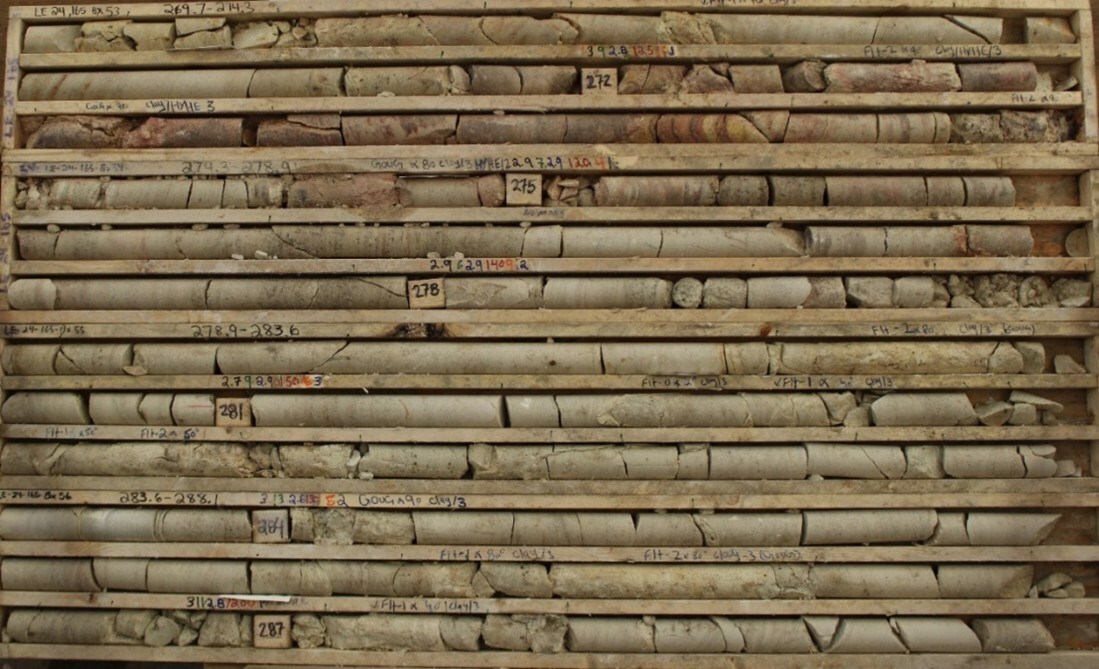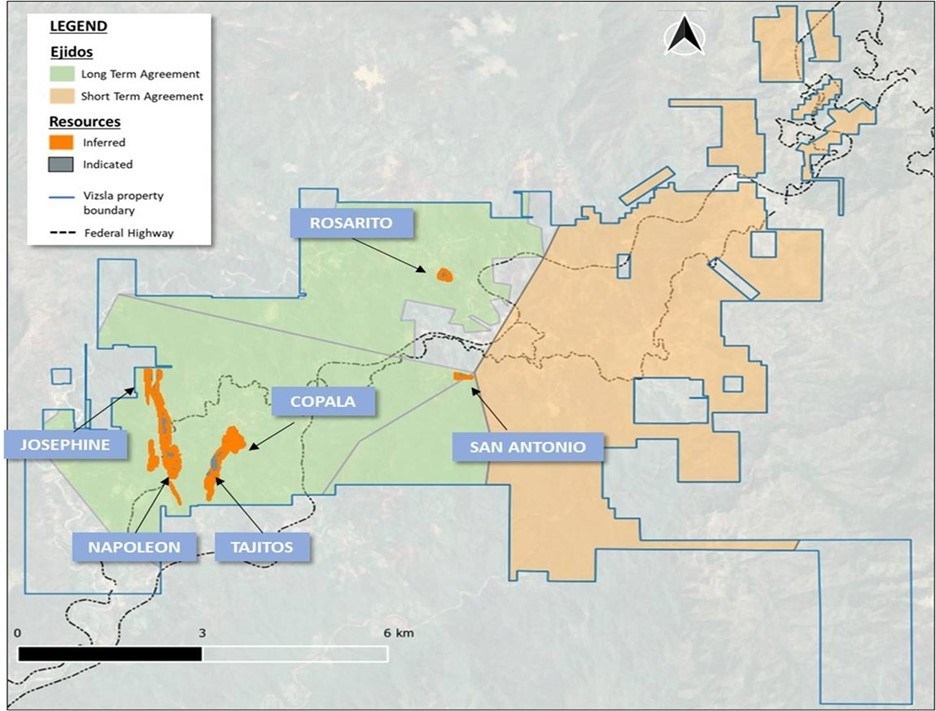TORONTO, CANADA (By IsoEnergy, 23.Jul.2025, Words: 1,205) — IsoEnergy Ltd. and Purepoint Uranium Group Inc. reported continued strong results from drilling at their 50/50 Dorado joint venture project, located in Saskatchewan’s world-class Athabasca Basin (Figure 1).
The most recent drill hole, PG25-07A, stepped out approximately 70m northeast of the “Nova Discovery” intercepts at the Q48 target area and returned stronger mineralization, with an average of 11,100 counts per second (CPS) measured on a Mount Sopris 2PGA-1000 downhole radiometric probe across a much wider interval of 14.0m, including a peak reading of 110,800 CPS.
The recent Nova Discovery results further define the mineralized trend at the Q48 target as a steeply dipping, uranium-bearing structure hosted within the basement rocks, underscoring the potential scale and strength of the system emerging at Dorado. All assays from the current program, including holes PG25-04 and PG25-05, are pending on a rush basis and will be disclosed once available.
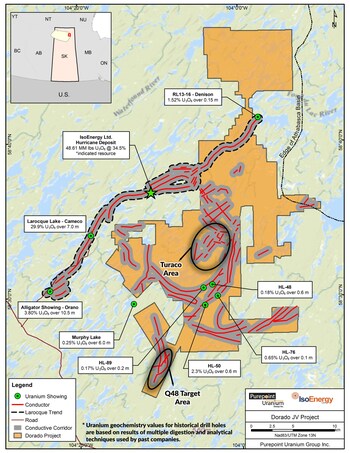
Highlights
- PG25-07A intersected a continuation of the Nova Discovery uranium basement hosted mineralization approximately 70 metres northeast of PG25-05 and 60m below the unconformity, averaging 11,100 CPS over 14.0m with a peak of 110,100 CPS.
- The Nova Discovery mineralization at Q48 remains open to the northeast, the direction of increasing radioactivity, but wet marsh ground conditions currently prevent further drilling in that direction. Follow-up drilling is expected to resume this winter, when frozen ground allows for more efficient land-based access.
- The drill rig has now been mobilized to the Turaco target, located approximately 8 km northeast of the Q48 target within the Dorado project. Up to four holes are planned at Turaco as part of the 5,400-m drill program approved by the joint venture partners for 2025.
“The recent Nova Discovery results underscore just how much potential remains at Dorado,” said Chris Frostad, President and CEO of Purepoint Uranium. “PG25-07A has successfully extended the Nova Discovery zone by 70 metres and delivered our strongest intercept to date, both in intensity and thickness based on radioactivity. The systematic way we’ve approached Q48 is paying off, and we expect the next phase of drilling will push this discovery even further.”
“The results from PG25-07A mark a significant leap forward for our new Nova discovery,” added Philip Williams, CEO and Director of IsoEnergy. “This step-out hole shows that the mineralized structure continues northeast and that the grades and thickness are improving as we move along the trend. While we have had to pause advancement in this direction due to ground conditions, we are eager to return this winter to continue following what we believe is shaping up to be an exciting discovery.”
DDHs PG25-06 and PG25-07A
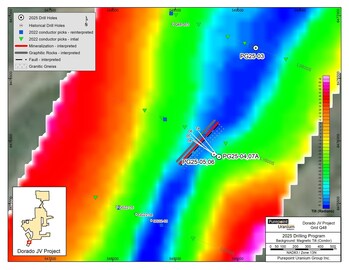
Drill hole PG25-06 targeted the brittle fault associated with mineralization (Figure 1) at the unconformity approximately 20m northeast of initial drilling (Figure 2). The drill hole was collared with a dip of -64 degrees and encountered Athabasca sandstone to a depth of 316m. Granitic gneiss displaying paleoweathering alteration was drilled to 341m then generally unaltered granite, pegmatites and pelitic gneiss was drilled to the completion depth of 482m. Projection of the Nova Discovery zone mineralization suggests the radioactive sandstone interval of 1,040 cps over 2.3m in the Mount Sopris 2PGA-1000 downhole gamma probe (Table 1), which occurs within core lost between 312.4 to 314.0m, is related to the primary mineralized structure.
Hole PG25-07A was collared from the PG25-04 drill pad and initial deviation resulted in a large 70m step out to the northeast of the PG25-05 mineralized intercept. The unconformity was intersected at a depth of 322m and the drill hole intercepted the radioactive structure approximately 40 metres up-dip of PG25-04. From the unconformity, granitic gneiss with pegmatitic intervals was encountered to a depth of 392m that was initially clay altered for 5 metres, weakly chlorite altered for 20 meters, unaltered for 36 metres, then became chloritized and silicified for 9 metres. Chloritized pelitic gneiss was drilled from 392m to 441m, unaltered graphitic and pyritic pelitic gneiss to 459m, followed by unaltered granitic gneiss and pegmatites with minor pelitic gneiss to the completion depth of 548 metres.
The PG25-07A Nova zone mineralization starts within granitic gneiss at 382.3m and extends into pelitic gneiss to a depth of 396.3 metres returning an average of 11,100 cps over 14.0 metres. A primary mineralized structure of the Nova zone is hosted in sheared, reddish-brown altered granitic gneiss with pitchblende that returned an average of 82,300 cps over 0.6m with a peak of 110,800 cps. A second strongly mineralized interval occurs within lost pelitic gneiss core and returned an average of 46,000 cps over 0.4m.
* See Qualified Person Statement below.
Table 1: Downhole Gamma Results of Drill Holes PG25-06 and 07A
| Hole ID | From (m) | To (m) | Length (m) | Avg. cps | Max. cps |
| PG25-06 | 250.8 | 251.5 | 0.7 | 665 | 805 |
| 312.6 | 314.9 | 2.3 | 1,040 | 1,770 | |
| 341.2 | 345.3 | 4.1 | 980 | 1,980 | |
| 347.6 | 348.4 | 0.8 | 860 | 1,060 | |
| 351.4 | 353.1 | 1.7 | 910 | 1,320 | |
| 403.3 | 404.7 | 1.4 | 1,410 | 2,600 | |
| PG25-07A | 382.3 | 396.3 | 14.0 | 11,100 | 110,800 |
| Includes | 385.5 | 386.1 | 0.6 | 82,300 | |
| Includes | 392.3 | 392.7 | 0.4 | 46,000 | |
| 397.4 | 399.8 | 2.4 | 4,500 | 20,200 | |
| 401.5 | 402.8 | 1.3 | 6,200 | 21,500 | |
| Includes | 402.0 | 402.4 | 0.4 | 14,400 | |
| 484.4 | 484.9 | 0.5 | 1,720 | 3,680 |
Note: Mt. Sopris 2PGA probe used to record downhole gamma readings
Q48 Target Area
The Q48 zone lies within the southern portion of the Project and is characterized by a steeply dipping, north-south trending conductive package identified through geophysical surveys. Historic drilling in the area intersected strongly altered and structurally disrupted rocks at the unconformity and in the basement, including garnetiferous pelitic gneiss, graphitic pelitic gneiss, and semipelite, with local weak radioactivity and zones of intense clay alteration. These results, combined with the geophysical response, highlighted Q48 as a highly prospective but underexplored target.
Drilling by IsoEnergy in 2022 confirmed that the conductive trend at Q48 hosts brittle faults, shears, and alteration, characteristics of uranium-bearing hydrothermal systems in the Athabasca Basin. The current program is designed to systematically follow-up and fully test the Q48 conductive corridor.
Turaco Target Area
The Turaco zone lies within the central portion of the Project and is characterized by a broad area with high conductivity. Although numerous geophysical surveys have been conducted, including airborne electromagnetics (VTEM), ground EM, induced polarization and gravity, previous drilling has failed to properly explain the interpreted EM conductors. A recent review of the geophysical results by Condor Consulting North of Vancouver, BC has selected alternative EM conductor picks that better explain the conductive responses and used Maxwell Modeling to accurately locate the position of discreet conductors. Drilling will commence at one of the high priority target areas identified by Condor.
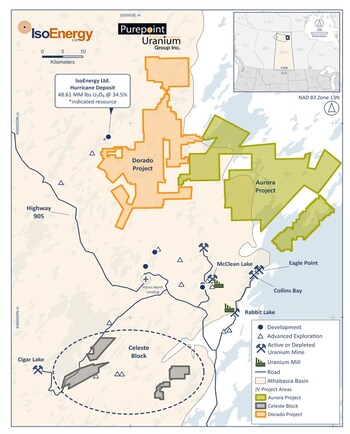
About the Dorado JV Project
Dorado (Figure 3) is the flagship project of the IsoEnergy-Purepoint 50/50 joint venture, a partnership encompassing more than 98,000 hectares of prime uranium exploration ground. The Project includes the former Turnor Lake, Geiger, Edge, and Full Moon properties, all underlain by graphite-bearing lithologies and fault structures favorable for uranium deposition.
Recent drilling by IsoEnergy east of the Hurricane Deposit has intersected strongly elevated radioactivity in multiple holes. The anomalous radioactivity confirms the continuity of fertile graphitic rock package and further highlights the opportunity for additional high-grade discoveries across the region.
The shallow unconformity depths across the Dorado property—typically between 30m and 300m—allow for highly efficient drilling and rapid follow-up on results.
____________________
